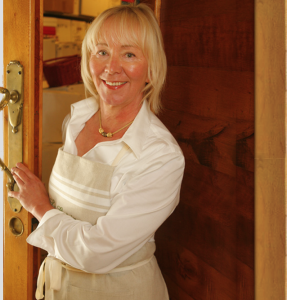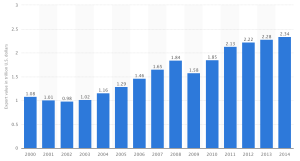Finnish-French Marketta Fourmeaux accomplished her dream of having her own winery in California. What else than a dream is needed to make a winery successful?

An oddball. When Marketta Fourmeaux moved to Napa Valley, California, in 1988, she heard she is an oddball. That was probably a nice way to put it. A blond in her mid-thirties, a mother of two, coming from France, born in Finland, said she wanted to buy a vineyard to make her own wine in California.
”Some people would have rather talked to my male dog than me!” Fourmeaux says and laughs. ”There were not many foreign winemakers nor female winemakers in California back then.”
Now, 30 years later, Marketta Fourmeaux is the only Finnish female wine-maker of Napa but no longer an oddball. California is a growing wine area attracting international investors. The U.S. is both consuming and exporting more and more wine – situation totally opposite to that of old wine empire France.
Fourmeaux has created two wine brands in California: Château Potelle and Marketta Winery, and now people pay close attention to what she says. She is a board member of The Wine Institute, the largest advocacy and public policy association for California wine, and the ex-president of the Mount Veeder Appellation Council.
She came to the U.S. well prepared.
Fourmeaux has a master’s degree in economics from Finland and a diploma in enology – the science of wine and viticulture– from France.
In 1976, one single happening in Paris changed Fourmeaux’s life and that same happening shook the world of wine. The Judgement of Paris, a prestigious blind tasting wine competition, rated California Chardonneys and Cabernet Sauvignons over French comparisons.
This was devastating news in France. Fourmeaux was then married to a Frenchman and evaluated wines for the honorable ”Institut des Appellations d’Origine”, the core of the qualifications of French wines.
A group of French wine producers asked her to travel to California to find out what is happening in its’ vineyards. Years earlier she had been an exchange student in California and her English was fluent. Fourmeaux agreed to travel to Napa. Later she sent a telegram home. It said: ”Looks good. We’ll stay.”
Wine is not an easy business. Making a vine grow is a basic form of agriculture, but farming vine to produce wine is much more complicated than farming vine to sell grapes or raisins. The quality of soil, the amount of rain and sun as well as the temperature all play a role in setting the taste and the quality of the final product. It is impossible to control nature. Fourmeaux says that the draught in California has not yet affected Napa Valley’s wine production but she is afraid of what the future brings. If northern California gets dryer, both the volume and the quality of its’ wine may decrease.
Now California produces 90 percent of the wine made in the U.S. The production, consumption and exports of Californian wines have all steadily grown during the time Fourmeaux has been here.
When she came much of the wine making was in the hands of big companies producing industrial bulk wine.
The prohibition law of the 1920s and 1930s had a long lasting effect on the wine culture of the U.S. It swept away many old vineyards, and later quality vines were replaced by lower-quality vines that grew thicker-skinned grapes, which could be more easily transported.
Much of the knowledge of artisanal winemaking was lost.
When Fourmeau bought the 273-acre estate Mount Vedeer in Napa Valley she planted new vines – Cabernet Sauvignon, Zinfandel, Syrah, Chardonnay and Sauvignon Blanc.
Americans ”new nothing about wine”, says Fourmeaux. The food culture and viticulture ”were not sophisticated in the 80s”, she says, but there was a reason for her to stay in California.
”I could have never became a winemaker in France. Here the oldest vineyards are run by maybe fifth generation of the same family. In France, it is the 15th generation. Foreigners are not accepted or taken seriously as winemakers in France.”
People doubted her in California too, but Fourmeaux says that the U.S. legislation made it easy to start a business and then proof that she can make good wine.
”Having a vineyard and winery in France means endless fighting with bureaucracy. Here I was able to concentrate immediately on developing the vineyard and the business.”
Fourmeaux wishes she could say that quality of wine means everything in sales but that is not true. The brand means nearly everything. Newcomer has to market aggressively.
”The most expensive wines of the world are not necessarily the best wines,” Formeaux says. The most wanted wines are the ones that have a name and fame.
Fourmeaux’s Mount Vedeer produced and sold around 300 000 bottles a year. It was a small, independent winery that had clients – restaurants, wine dealers and direct buyers – who had learnt to know the winemaker and appreciated her talent and brand. They were not looking for big volumes or a cheap price.
This kind of production is very vulnerable in economic turmoils.
The volume of the wine production of the U.S. has grown in past ten years from 35 million gallons to 117 million gallons. At the same time, the revenues to wineries grew from from $196 million to $1,494 million. There was a drop of one million dollars between the years 2009 and 2010, after the financial crisis of 2008.
”Premium wine is a luxury product. Many of my clients have big wine cellars. After the market crash they stopped buying new wines and started drinking the ones they already had in their cellars,” says Fourmeaux.
”I know many small winery owners who have been forced to quit because they haven’t had capital to overcome bad years.”
”I could have never became a winemaker in France. Here the oldest vineyards are run by maybe fifth generation of the same family. In France, it is the 15th generation. Foreigners are not accepted or taken seriously as winemakers in France.”
Fourmaux was forced to give up the Mount Vedeer estete and Château Potelle brand when she divorced. She now buys grapes from vineyards she has helped during her years in California and gets to choose the ones she wants. She gets a small amount from her own backyard plot of 100 acres. She matures and blends her current wine called Marketta in downtown Napa.
Marketta Winery produces only about 100 boxes of wine per year and sells them to two restaurants and loyal old customers. Earlier her wines were exported to Europe. Today Fourmeaux prefers to keep her business small although she knows that there are potential markets.
The European Union’s 28 member countries are the largest export market for California wine. Last year they accounted for $518 million and 35 percent of the exports. Canada is the second largest export market with value of $487 million. Following eight export areas are Japan ($88 million), China ($71 million), Hong Kong ($69 million), Mexico($24 million), South Korea ($22.2 million), Nigeria ($21.9 million), Vietnam ($20 million) and Singapore ($16 million).
”Cheap dollar helped the exports for many years”, says Fourmeaux.
With weakening Euro, exports to Europe are down slightly. The Wine Institute of California is not expecting the situation to get any better in the near future.
The UK however, is seen as a more promising market. The sales of wines at low prices are decreasing in the UK but the sales of wines costing $15 or more increased last year by 30 percent.
In Japan, the situation is similar to the UK. The volume of the exports to Japan is decreasing because less and less bulk wine is shipped to Japan but at the same time Japanese show more interest in premium California wine.
Since 2011, the value of wine exports to Asia has doubled, and the future looks bright.
Even though the economy of China is currently slowing down and California wine exports to China and Hong Kong decreased last year. “Asia’s emerging wine markets remained buoyant in 2014 despite the negative impact of China’s ongoing austerity campaign”, reports The Wine Institute. ”However the long-term outlook for these key markets remains very promising.”
Wine industry lobbied strongly for the Trans-Pacific Trade Agreement and is pleased with the result so far. Wine trade will remain under special regulation but many trade barriers are to be eliminated.
If Marketta Fourmeaux was now to advice a young, enthusiastic winemaker on where to start her own winery, she would not recommend California.
”The land is so expensive. One acre of vine costs 250,000 dollars or even more.”
California attires affluent investors, and in Marketta Fourmeaux’s opinion some of them come here out of vanity. ”They want to make themselves nobles by buying a vineyard.”
California still has many advantages. The climate is ideal, and it is easy to get cheap work force from Mexico.
The country’s wine consumption is growing. The U.S. is now number two in wine consumption in the world and will likely bypass France soon. In per capita consumption, the U.S. is only the 23rd in the world when France holds the second place – after tiny Luxemburg. There should be plenty of room to sell more and more wine to the Americans.
However, Marketta Fourmeaux would advise a new winemaker to start in South America – or maybe in India which is an emerging wine area.
Chinese drink more and more Western style wine, and the climate is good for growing grapes in many parts of the huge country. China is already a huge producer of raisins. But China does not welcome foreign entrepreneurs in its’ agriculture.
France and Italy have long been the largest wine producers of the world. These old world countries are slowly losing their positions. The traditional, hierarchical, male-dominated wine industry is not appealing to young consumers nor innovative entrepreneurs.
Fourmeaux thinks this could actually open paths for new winemakers in lesser-known wine areas of France.
Marketta Fourmeaux is sure that one does not need to be an economist to become a successful wine producer. One needs to know wine and be ready to work hard.

Leave a Reply
You must be logged in to post a comment.